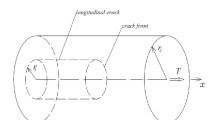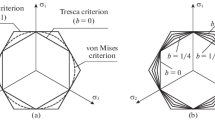Abstract
A closed form solution is obtained, within the limitations of the theory of elasticity of non-homogeneous solids, for a cylindrical bar containing a penny-shaped crack and subjected to torsional loads only. The material of the solid is assumed to possess a shear modulus which is a power function of the space coordinate normal to the crack plane. The singular stress field arising at the rim of the crack is studied in detail and some physical results which are relevant in the application of the Griffith-Irwin theory of fracture are derived.
Résumé
Dans les limites de la théorie de l'élasticité des solides non uniformes, on trouve une solution de forme fermée au probléme de la barre cylindrique, comprenant une fissure noyée de forme circulaire, et soumise á des charges de torsion pure.
On suppose que le materiau constituant le solide est caractérisé par un module de cisaillement qui est fonction d'une certaine puissance de la distance normale au plan de la fissure.
Le champ singulier de contraintes an bord de la fissure est etudie dans le detail, et certains resultats physiques sont deduits, qui sont conformes à l'application de la théorie de Griffith-Orowan.
Zusammenfassung
Für einen nur Verdrehungsspannungen ausgesetzten Rundstab mit einem Pfennig-förmigen RiB wird im Rahmen der Elastizitätstheorie unhomogener Festkörper eine Lösung in geschlossener Form ermittelt. Es wird vorausgesetzt, daß der Schermodul des Festkörpers eine Potenzialfunktion der senkrecht zur Rißebene liegenden Raumkoordinaten ist. Das sich am RiBrande bildende singulare Spannungsfeld wird in seinen Einzelheiten geprüft; außerdem werden einige physikalische Ergebnisse abgeleitet die für die Anwendung der Bruchtheorie von Bedeutung sind.
Similar content being viewed by others
References
P. C. Paris and G. C. Sih, Stress Analysis of Cracks, Fracture Toughness Testing and its Applications, STP 381, pp. 30–76, ASTM, Philadelphia (1965).
I. N. Sneddon and M. Lowengrub, Crack Problems in the Classical Theory of Elasticity, John Wiley, New York, (1969)3–7 and 158–160.
I. N. Sneddon and R. P. Srivastav, Dual Series Relations, Proc. Roy. Soc. Edinburgh, A 66 (1966) 150–160.
M. K. Kassir, The Reissner-Sagoci Problem for a Non-Homogeneous Solid, Int. J. of Engng. Science, 8 (1970) 875–885.
E. I. Copson, Dual Integral Equations, Proc. Glasgow Math. Assoc., 5 (1961) 21–24.
A. Weinstein, On Cracks and Dislocations in Shafts Under Torsion, Quart. of Applied Math., 10 (1952) 77–81.
G. R. Irwin, Fracture Mechanics, Structural Mechanics, Edited by Hopf and Goodier, Pergamon Press, London, England, (1960) 560–574.
W. N. Baily, Infinite Integrals Involving Bessel Functions. Proc. London Math. Soc., 40 (1936) 37–48.
A. Erdelyi (Editor), Higher Transcendental Functions, Vol. I, McGraw Hill, (1953) 242–249.
M. K. Kassir and G. C. Sih, Three-Dimensional Stress Distribution Around an Elliptical Crack Under Arbitrary Loading, J. of App. Mech., Trans. ASME, 33 (1966) 601–611.
Author information
Authors and Affiliations
Rights and permissions
About this article
Cite this article
Kassir, M.K. A note on the twisting deformation of a non-homogeneous shaft containing a circular crack. Int J Fract 8, 325–334 (1972). https://doi.org/10.1007/BF00186131
Received:
Issue Date:
DOI: https://doi.org/10.1007/BF00186131




